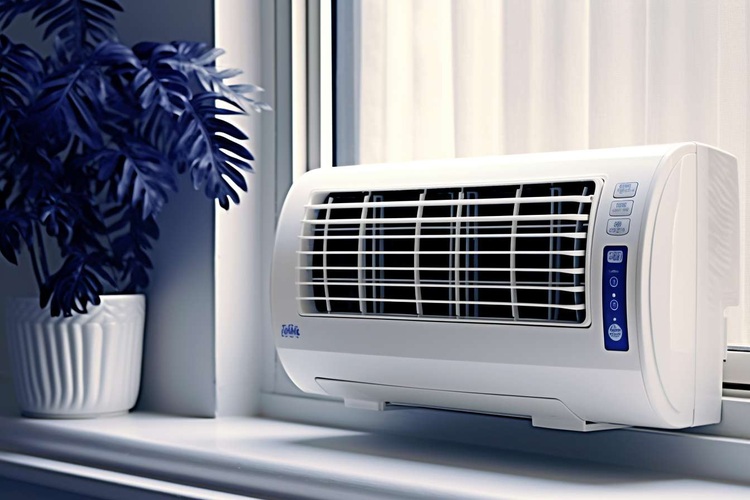Portable Air Conditioners and Window AC Units Explained
Portable air conditioners are self-contained cooling units that can be easily moved from room to room. These devices typically have wheels for mobility and require minimal installation. Portable ACs work by drawing in warm air from the room, cooling it, and then expelling the hot air through an exhaust hose that is vented out of a window or door. They are ideal for spaces where traditional window units are not feasible or for those who need a temporary cooling solution.

What are portable air conditioners?
Portable air conditioners are standalone cooling units designed to move easily from room to room without permanent installation. These self-contained systems typically feature wheels or casters for mobility and include all necessary components within a single cabinet. Unlike traditional central air systems, portable units draw warm air from the room, cool it using refrigerant coils, and expel the heated air outside through a flexible exhaust hose that connects to a window or sliding door.
Most portable air conditioners operate using a single-hose or dual-hose system. Single-hose models pull air from the room for both cooling the condenser and circulation, while dual-hose systems separate these functions for improved efficiency. These units generally include built-in condensate collection systems, digital controls, and multiple fan speeds to customize comfort levels.
How do window AC units differ from portable models?
Window AC units mount directly into window frames, creating a semi-permanent cooling solution that sits partially inside and outside the room. The key difference lies in their installation method and air circulation design. Window units draw outside air directly over the condenser coils, which provides more efficient heat exchange compared to portable models that must work with indoor air.
Installation requirements also vary significantly between the two options. Window AC units require a suitable window opening and adequate structural support, as they hang partially outside the building. Portable air conditioners need only a window or door opening large enough for the exhaust hose, making them suitable for situations where window installation isn’t possible or permitted.
What are the key features of portable air conditioners?
Modern portable air conditioners offer numerous features designed for convenience and efficiency. Most units include programmable timers, sleep modes, and remote controls for easy operation. Many models feature multiple operating modes beyond cooling, including dehumidification and fan-only settings that extend their usefulness throughout different seasons.
Energy efficiency ratings, measured in BTU (British Thermal Units) per hour, typically range from 8,000 to 14,000 BTU for residential models. Additional features often include digital displays, automatic restart functions after power outages, and washable air filters. Some advanced models incorporate Wi-Fi connectivity for smartphone control and smart home integration.
How do window AC units contribute to cooling solutions for homes?
Window AC units provide efficient targeted cooling for individual rooms or specific areas within homes. Their fixed installation allows for optimized airflow patterns and typically delivers superior cooling performance per BTU compared to portable alternatives. The direct outdoor air access enables these units to operate more efficiently, especially in extremely hot climates.
These systems work particularly well in older homes without central air conditioning or in situations where adding ductwork would be impractical or expensive. Window units can supplement existing HVAC systems by providing additional cooling capacity in frequently used rooms, potentially reducing overall energy consumption by allowing homeowners to raise thermostat settings in other areas.
How do portable air conditioners and window AC units compare in terms of cost and efficiency?
Understanding the financial implications of each cooling option involves examining both upfront costs and ongoing operational expenses. The initial purchase price varies significantly based on cooling capacity, features, and brand reputation, while efficiency differences impact long-term electricity costs.
| Unit Type | Capacity Range | Price Range | Energy Efficiency | Installation Cost |
|---|---|---|---|---|
| Portable AC | 8,000-14,000 BTU | $300-$700 | Lower (EER 8-10) | $0 (DIY setup) |
| Window AC | 5,000-24,000 BTU | $150-$500 | Higher (EER 10-12) | $50-$200 (if professional) |
| Portable AC (Premium) | 10,000-14,000 BTU | $500-$900 | Moderate (EER 9-11) | $0 (DIY setup) |
Window AC units generally offer superior energy efficiency, consuming less electricity to produce equivalent cooling output. However, portable units provide flexibility for renters or those who need cooling in multiple locations. Operating costs depend on local electricity rates, usage patterns, and the specific efficiency ratings of individual models.
Prices, rates, or cost estimates mentioned in this article are based on the latest available information but may change over time. Independent research is advised before making financial decisions.
Both portable air conditioners and window AC units serve as practical cooling solutions with distinct advantages depending on your specific circumstances. While window units typically offer better energy efficiency and cooling performance per dollar spent, portable models provide unmatched flexibility and easier installation. Consider factors such as your living situation, cooling needs, budget constraints, and local climate conditions when choosing between these two cooling options. Either choice can provide reliable relief from summer heat when properly sized and maintained for your space.




